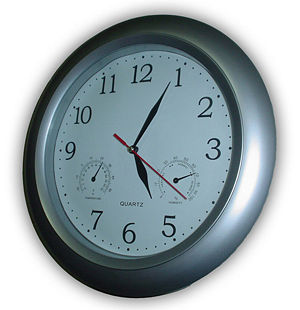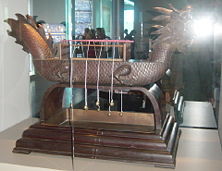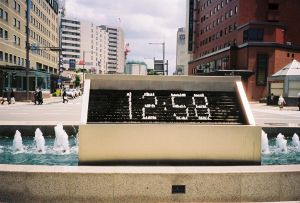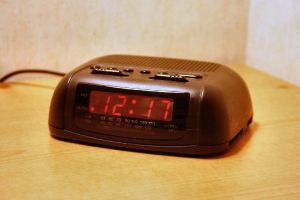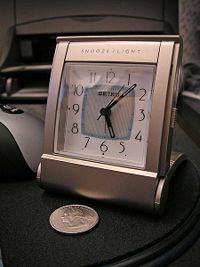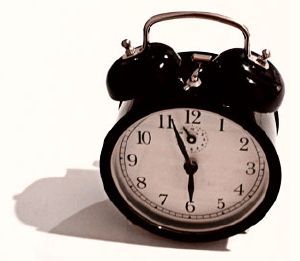Clock
A clock (from the Latin word cloca, meaning "bell") is an instrument for measuring time. In its most common form, in use since at least the fourteenth century, it displays the time in hours, minutes, and often seconds, during a 12 or 24 hour period.
Clocks that are used for telling the time at very high accuracy are usually called chronometers. A common, portable timekeeping instrument for personal use is the pocket watch or wristwatch.
By definition, a "true" clock has an announcing or striking mechanism that sounds after each set interval of time. The sound could be the ringing of a bell, chimes, or gong. A silent clock without a striking mechanism is traditionally known as a timepiece, a term sometimes used by horologists and other specialists to describe devices such as ordinary wristwatches (Baillie et al., p. 307; Palmer, p. 19; Zea and Cheney, p. 172).
History
The clock is one of the oldest human inventions, requiring a physical process that will proceed at a known rate and a way to gauge how long that process has run. As the seasons and the phases of the moon can be used to measure the passage of longer periods of time, shorter processes had to be used to measure off hours and minutes.
Sundials and other techniques
The sundial, which measures the time of day by the direction of shadows cast by the sun, was widely used in ancient times. A well-designed sundial can measure local solar time with reasonable accuracy, and sundials continued to be used to monitor the performance of clocks until the modern era. However, its practical limitationsâit requires the sun to shine and doesn't work at all during the nightâencouraged the use of other techniques for measuring time.
Candles and sticks of incense that burn down at, approximately, predictable speeds have also been used to estimate the passing of time. In an hourglass, fine sand pours through a tiny hole at a constant rate and indicates a predetermined passage of an arbitrary period of time.
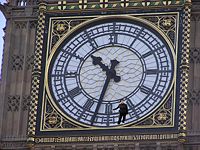
Waterclocks
Vitruvius reported that the ancient Egyptians used a clepsydra, a time mechanism using flowing water. Herodotus had mentioned an ancient Egyptian time-keeping device that was based on mercury. By the ninth century C.E., a mechanical timekeeper had been developed that lacked only an escapement mechanism. Later years saw the rise of automated water clocks in Arabia, China, and Korea.
Early mechanical clocks
None of the first clocks survive from thirteenth century Europe, but various mentions in church records reveal some of the early history of the clock.
Medieval religious institutions required clocks to measure and indicate the passing of time because, for many centuries, daily prayer and work schedules had to be strictly regulated. This was done by various types of time-telling and recording devices, such as water clocks, sundials and marked candles, probably used in combination. Important times and durations were broadcast by bells, rung either by hand or by some mechanical device such as a falling weight or rotating beater.
The word horologia (from the Greek hora, hour, and legein, to tell) was used to describe all these devices, but the use of this word (still used in several romance languages) for all timekeepers conceals the true nature of the mechanisms. For example, there is a record that in 1176 Sens Cathedral installed a horologe but the mechanism used is unknown. In 1198, during a fire at the abbey of St Edmundsbury (now Bury St Edmunds), the monks "ran to the clock" to fetch water, indicating that their water clock had a reservoir large enough to help extinguish the occasional fire.
These early clocks may not have used hands or dials, but âtoldâ the time with audible signals.
A new mechanism
The word "clock" (from the Latin word for "bell"), which gradually supersedes "horologe," suggests that it was the sound of bells which also characterized the prototype mechanical clocks that appeared during the thirteenth century.
Between 1280 and 1320, there was an increase in the number of references to clocks and horologes in church records, and this probably indicates that a new type of clock mechanism had been devised. Existing clock mechanisms that used water power were being adapted to take their driving power from falling weights. This power was controlled by some form of oscillating mechanism, probably derived from existing bell-ringing or alarm devices. This controlled release of powerâthe escapementâmarks the beginning of the true mechanical clock.
These mechanical clocks were intended for two main purposes: For signaling and notification (e.g. the timing of services and public events), and for modeling the solar system. The former purpose was administrative, the latter arose naturally given the scholarly interest in astronomy, science, astrology, and how these subjects integrated with the religious philosophy of the time. The astrolabe was used both by astronomers and astrologers, and it was natural to apply a clockwork drive to the rotating plate to produce a working model of the solar system.
Simple clocks intended mainly for notification were installed in towers, and did not always require dials or hands. They would have announced the canonical hours or intervals between set times of prayer. Canonical hours varied in length as the times of sunrise and sunset shifted. The more sophisticated astronomical clocks would have had moving dials or hands, and would have shown the time in various time systems, including Italian hours, canonical hours, and time as measured by astronomers at the time. Both styles of clock started acquiring extravagant features such as automata.
In 1283, a large clock was installed at Dunstable Priory; its location above the rood screen suggests that it was not a water clock. In 1292, Canterbury Cathedral installed a "great horloge." Over the next 30 years there are brief mentions of clocks at a number of ecclesiastical institutions in England, Italy, and France. In 1322, a new clock was installed in Norwich, an expensive replacement for an earlier clock installed in 1273. This had a large (2 meter) astronomical dial with automata and bells. The costs of the installation included the full-time employment of two technicians for two years.
Early astronomical clocks
The clocks constructed by Richard of Wallingford in St Albans by 1336, and by Giovanni de'Dondi in Padua from 1348 to 1364, no longer exist, but detailed descriptions of their design and construction survive, and modern reproductions have been made. They illustrate how quickly the theory of the mechanical clock had been translated into practical constructions, and also that one of the many impulses to their development had been the desire of astronomers to investigate celestial phenomena.
Wallingford's clock had a large astrolabe-type dial, showing the sun, the moon's age, phase, and node, a star map, and possibly the planets. In addition, it had a wheel of fortune and an indicator of the state of the tide at London Bridge. Bells rang every hour, the number of strokes indicating the time.
Dondi's clock was a seven-sided construction, 1 meter high, with dials showing the time of day, including minutes, the motions of all the known planets, an automatic calendar of fixed and movable feasts, and an eclipse prediction hand rotating once every 18 years.
It is not known how accurate or reliable these clocks would have been. They were probably adjusted manually every day to compensate for errors caused by wear and imprecise manufacture.
The Salisbury Cathedral clock, built toward the end of the fourteenth century, is considered to be the oldest surviving mechanical clock in the world.
Elements of the mechanical clock
These fourteenth century clocks show the four key elements common to all clocks in subsequent centuries, at least up to the digital age:
- the power, supplied by a falling weight, later by a coiled spring
- the escapement, a periodic repetitive action that allows the power to escape in small bursts rather than drain away all at once
- the going train, a set of interlocking gear wheels that controls the speed of rotation of the wheels connected between the power supply and the indicators
- indicators, such as dials, hands, and bells
Later developments
Clock makers developed their art in various ways. Building smaller clocks was a technical challenge, as was improving accuracy and reliability. Clocks could be impressive showpieces to demonstrate skilled craftsmanship, or less expensive, mass-produced items for domestic use. The escapement in particular was an important factor affecting the clock's accuracy, so many different mechanisms were tried.
Spring-driven clocks were developed during the fifteenth century, and this gave the clockmakers many new problems to solve, such as how to compensate for the changing power supplied as the spring unwound.
The first record of a minute hand on a clock is 1475, in the Almanus Manuscript of Brother Paul.
During the fifteenth and sixteenth centuries, clockmaking flourished, particularly in the metalworking towns of Nuremberg and Augsburg, and in France, Blois. Some of the more basic table clocks have only one time-keeping hand, with the dial between the hour markers being divided into four equal parts making the clocks readable to the nearest 15 minutes. Other clocks were exhibitions of craftsmanship and skill, incorporating astronomical indicators and musical movements. The cross-beat escapement was developed in 1585 by Jost Burgi, who also developed the remontoire. Burgi's accurate clocks helped Tycho Brahe and Johannes Kepler to observe astronomical events with much greater precision than before.
The first record of a second hand on a clock is about 1560, on a clock now in the Fremersdorf collection. However, this clock could not have been accurate, and the second hand was probably for indicating that the clock was working.
The next development in accuracy occurred after 1657, with the invention of the pendulum clock. Galileo had the idea to use a swinging bob to propel the motion of a time telling device earlier in the seventeenth century. Christiaan Huygens, however, is usually credited as the inventor. He determined the mathematical formula that related pendulum length to time (99.38 centimeters or 39.13 inches for the one second movement) and had the first pendulum-driven clock made. In 1670, the English clockmaker William Clement created the anchor escapement, an improvement over Huygens' crown escapement. Within just one generation, minute hands and then second hands were added.
A major stimulus to improving the accuracy and reliability of clocks was the importance of precise time-keeping for navigation. The position of a ship at sea could be determined with reasonable accuracy if a navigator could refer to a clock that lost or gained less than about 10 seconds per day. This clock could not contain a pendulum, which would be virtually useless on a rocking ship. Many European governments offered a large prize for anyone that could determine longitude accurately; for example, Great Britain offered 20,000 pounds, equivalent to millions of dollars today. The reward was eventually claimed in 1761 by John Harrison, who dedicated his life to improving the accuracy of his clocks. His H5 clock is reported to have lost less than 5 seconds over 10 days.
The excitement over the pendulum clock had attracted the attention of designers resulting in a proliferation of clock forms. Notably, the longcase clock (also known as the "grandfather clock") was created to house the pendulum and works. The English clockmaker William Clement is also credited with developing this form in 1670 or 1671. It was also at this time that clock cases began to be made of wood and clock faces to utilize enamel as well as hand-painted ceramics.
On November 17, 1797, Eli Terry received his first patent for a clock. Terry is known as the founder of the American clock-making industry.
Alexander Bain, Scottish clockmaker, patented the electric clock in 1840. The electric clock's mainspring is wound either with an electric motor or with an electro-magnet and armature. In 1841, he first patented the electromagnetic pendulum.
The development of electronics in the twentieth century led to clocks with no clockwork parts at all. Time in these cases is measured in several ways, such as by the vibration of a tuning fork, the behavior of quartz crystals, the decay of radioactive elements, or resonance of polycarbonates. Even mechanical clocks have since come to be largely powered by batteries, removing the need for winding.
Types
Clocks can be classified by the type of time display, as well as by the method of timekeeping.
Time display methods
Analog clocks
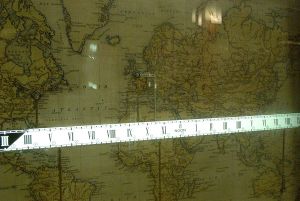
Analog clocks usually indicate time using angles. The most common clock face uses a fixed numbered dial or dials and moving hand or hands. It usually has a circular scale of 12 hours, which can also serve as a scale of 60 minutes, and often also as a scale of 60 secondsâthough many other styles and designs have been used throughout the years, including dials divided into 6, 8, 10, and 24 hours. Of these alternative versions, the 24 hour analog dial is the main type in use today. The 10-hour clock was briefly popular during the French Revolution, when the metric system was applied to time measurement, and an Italian 6 hour clock was developed in the eighteenth century, presumably to save power (a clock or watch chiming 24 times uses more power).
Another type of analog clock is the sundial, which tracks the sun continuously, registering the time by the shadow position of its gnomon. Sundials use some or part of the 24 hour analog dial.
There also exist clocks which use a digital display despite having an analog mechanismâthese are commonly referred to as flip clocks.
Digital clocks
Main Article: Digital clock
Digital clocks display a numeric representation of time. Two numeric display formats are commonly used on digital clocks:
- the 24-hour notation with hours ranging 00â23;
- the 12-hour notation with a.m./p.m. indicator, with hours indicated as 12a.m., followed by 1 a.m.â11 a.m., followed by 12 p.m., followed by 1 p.m.â11 p.m. (a notation mostly used in the United States).
Most digital clocks use an LCD or LED display; many other display technologies are used as well (cathode ray tubes, nixie tubes, etc.). After a reset, battery change, or power failure, digital clocks without a backup battery or capacitor either start counting from 00:00, or stay at 00:00, often with blinking digits indicating that time needs to be set. Some newer clocks will actually reset themselves based on radio or Internet time servers that are tuned to national atomic clocks.
Auditory clocks
For convenience, distance, telephony, or blindness, auditory clocks present the time as sounds. The sound is either spoken natural language, (e.g. "The time is twelve thirty-five"), or as auditory codes (e.g. number of sequential bell rings on the hour represents the number of the hour, like the clock Big Ben).
Timekeeping methods
Most types of clocks are built around some form of oscillator, an arrangement that goes through an endless sequence of periodic state changes, designed to provide a continuous and stable reference frequency. The periods of this oscillator are then counted and converted into the desired clock display.
- Mechanical clocks use a pendulum as their oscillator, which controls the rotation of a system of gears that drive the clock display.
- Crystal clocks use an electronic quartz crystal oscillator and a frequency divider or counter. Most battery-powered crystal clocks use a 215 Hertz (Hz) = 32.768 Kilohertz (kHz) oscillator.
- Atomic clocks use a microwave oscillator (maser) tuned by the energy transitions of elements such as caesium, rubidium, or hydrogen. These are the most precise clocks available. Atomic clocks based on caesium are used as the official definition of time today.
- Mains power clocks count the 50 or 60 hertz periods of their AC power.
- Radio clocks receive time signal broadcasts from a radio transmitter (which may be hundreds of kilometers away). The clock can decode the transmission and adjust its hands or display for perfect accuracy. The broadcast radio signals are generated by an atomic clock and typically have a data rate of 1 bit/s.
- Sundials observe the apparent rotation of the Sun around the Earth as their reference oscillation. They are observed with a solar tempometer.
Purposes
Clocks are in homes and offices; smaller ones (watches) are carried; larger ones are in public places, e.g. a train station or church. A small clock is often shown in a corner of computer displays or mobile phones.
The purpose of a clock is not always to display the time. It may also be used to control a device according to time, e.g. an alarm clock, or a VCR, (see: counter). However, in this context, it is more appropriate to refer to it as a timer or trigger mechanism rather than strictly as a clock.
Computers depend on an accurate internal clock signal to allow synchronized processing. (A few research projects are developing CPUs based on asynchronous circuits.) Some computers also maintain time and date for all manner of operations whether these be for alarms, event initiation, or just to display the time of day. The internal computer clock is generally kept running by a small battery. Memory of this kind is often referred to as "non-volatile." Many computers will still function even if the internal clock battery is dead, but the computer clock will need to be reset each time the computer is restarted, since once power is lost, time is also lost.
Ideal clocks
An ideal clock is a scientific principle that measures the ratio of the duration of natural processes, and thus will give the time measure for use in physical theories. Therefore, to define an ideal clock in terms of any physical theory would be circular. An ideal clock is more appropriately defined in relationship to the set of all physical processes. An ideal clock should too measure time in consistent, for example decimalized time units.
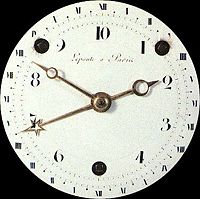
This leads to the following definitions:
- A clock is a recurrent periodic process and a counter.
- A good clock is one which, when used to measure other recurrent processes, finds many of them to be periodic.
- An ideal clock is a clock (i.e., recurrent process) that makes the most other recurrent processes periodic.
The recurrent, periodic process (a metronome) is an oscillator and typically generates a "clock signal." Sometimes that signal alone is (confusingly) called "the clock," but sometimes "the clock" includes the counter, its indicator, and everything else supporting it.
This definition can be further improved by the consideration of successive levels of smaller and smaller error tolerances. While not all physical processes can be surveyed, the definition should be based on the set of physical processes which includes all individual physical processes which are proposed for consideration. Since atoms are so numerous and since, within current measurement tolerances they all beat in a manner such that if one is chosen as periodic then the others are all deemed to be periodic also, it follows that atomic clocks represent ideal clocks to within present measurement tolerances and in relation to all presently known physical processes. However, they are not so designated by fiat. Rather, they are designated as the current ideal clock because they are currently the best instantiation of the definition.
Navigation by ships depends on the ability to measure latitude and longitude. Latitude is fairly easy to determine through celestial navigation, but the measurement of longitude requires accurate measurement of time. This need was a major motivation for the development of accurate mechanical clocks. John Harrison created the first, highly accurate marine chronometer in the mid-eighteenth century. The Noon gun in Cape Town still fires an accurate signal to allow ships to check their chronometers.
Specific types of clocks
- Alarm clock
- Analog clock with digital display
- Astronomical clock
- Atomic clock
- Balloon clock
- Binary clock
- Bracket clock
- Carriage clock
- Cartel clock
- Chiming clock
- Clock network
- Clock of the Long Now
- Countdown clock
- Cuckoo clock
- Data clock for timescapes created with time-technology
- Digital clock
- Doll's head clock
- Electric clock
- Flip clock
- Floral clock
- Game clock
- Hourglass
- Japanese clock
- Lantern clock
- Lighthouse Clock
- Longcase (or "grandfather") clock
- Mantel clock
- Master clock
- Paper clock
- Pedestal clock
- Pendulum clock
- Projection clock
- Quartz clock
- Railroad chronometers
- Reference clock
- Rolling ball clock
- Shelf clock
- Sidereal clock
- Skeleton clock
- Slave clock
- Stopwatch
- Striking clock
- Sundial
- Tall-case clock
- Tide clock
- Time ball
- Time clock
- Tower clock
- Torsion pendulum clock
- Watch
- Water clock
- Wall clock
- World clock
ReferencesISBN links support NWE through referral fees
- Baillie, G.H., O. Clutton, & C.A. Ilbert. 1956. Brittenâs Old Clocks and Watches and Their Makers. 7th ed. Bonanza Books.
- Bolter, David J. 1984. Turing's Man: Western Culture in the Computer Age. Chapel Hill, NC: University of North Carolina Press. ISBN 0-8078-4108-0
- Bruton, Eric. 2003. The History of Clocks and Watches. New York: Little, Brown. ISBN 0316724262
- Edey, Winthrop. 1967. French Clocks. New York: Walker & Co. ISBN 0289370566
- Landes, David S. 1983. Revolution in Time: Clocks and the Making of the Modern World. Cambridge: Harvard University Press.
- Lloyd, Alan H. 1957. "Mechanical Timekeepers," in A History of Technology Vol. III. Edited by Charles Joseph Singer et al. Oxford: Clarendon Press.
- Macey, Samuel L. 1980. Clocks and the Cosmos: Time in Western Life and Thought. Hamden, CT: Archon Books. ISBN 0208017739
- North, John. 2007. God's Clockmaker: Richard of Wallingford and the Invention of Time. London: Hambledon and London. ISBN 1852855711
- Palmer, Brooks. 1979. The Book of American Clocks. London: Macmillan Co.
- Robinson, Tom. 2006. The Longcase Clock. Suffolk, UK: Antique Collectorâs Club. ISBN 1851492321
- Smith, Alan. 1996. The International Dictionary of Clocks. London: Chancellor Press. ISBN 0671068091
- Tardy. 1981. French Clocks the World Over. Part I and II. Translated with the assistance of Alexander Ballantyne. Paris: Tardy.
- Yoder, Joella Gerstmeyer. 1988. Unrolling Time: Christiaan Huygens and the Mathematization of Nature. New York: Cambridge University Press. ISBN 052134140X
- Zea, Philip, and Robert Cheney. 1992. Clock Making in New England: 1725-1825. Sturbridge, MA: Old Sturbridge Village. ISBN 0913387037
External links
All links retrieved January 7, 2024.
- 49-hour septenary clock.
- United States National Association of Watch and Clock Collectors.
- American Watchmakers-Clockmakers Institute.
- British Horological Institute.
- Federation of the Swiss Watch Industry FH contains listings of links to all participating Swiss Watch Brands and related manufacturers, suppliers, associations, trade magazines, etc, as well as a wealth of related information.
Credits
New World Encyclopedia writers and editors rewrote and completed the Wikipedia article in accordance with New World Encyclopedia standards. This article abides by terms of the Creative Commons CC-by-sa 3.0 License (CC-by-sa), which may be used and disseminated with proper attribution. Credit is due under the terms of this license that can reference both the New World Encyclopedia contributors and the selfless volunteer contributors of the Wikimedia Foundation. To cite this article click here for a list of acceptable citing formats.The history of earlier contributions by wikipedians is accessible to researchers here:
The history of this article since it was imported to New World Encyclopedia:
Note: Some restrictions may apply to use of individual images which are separately licensed.
